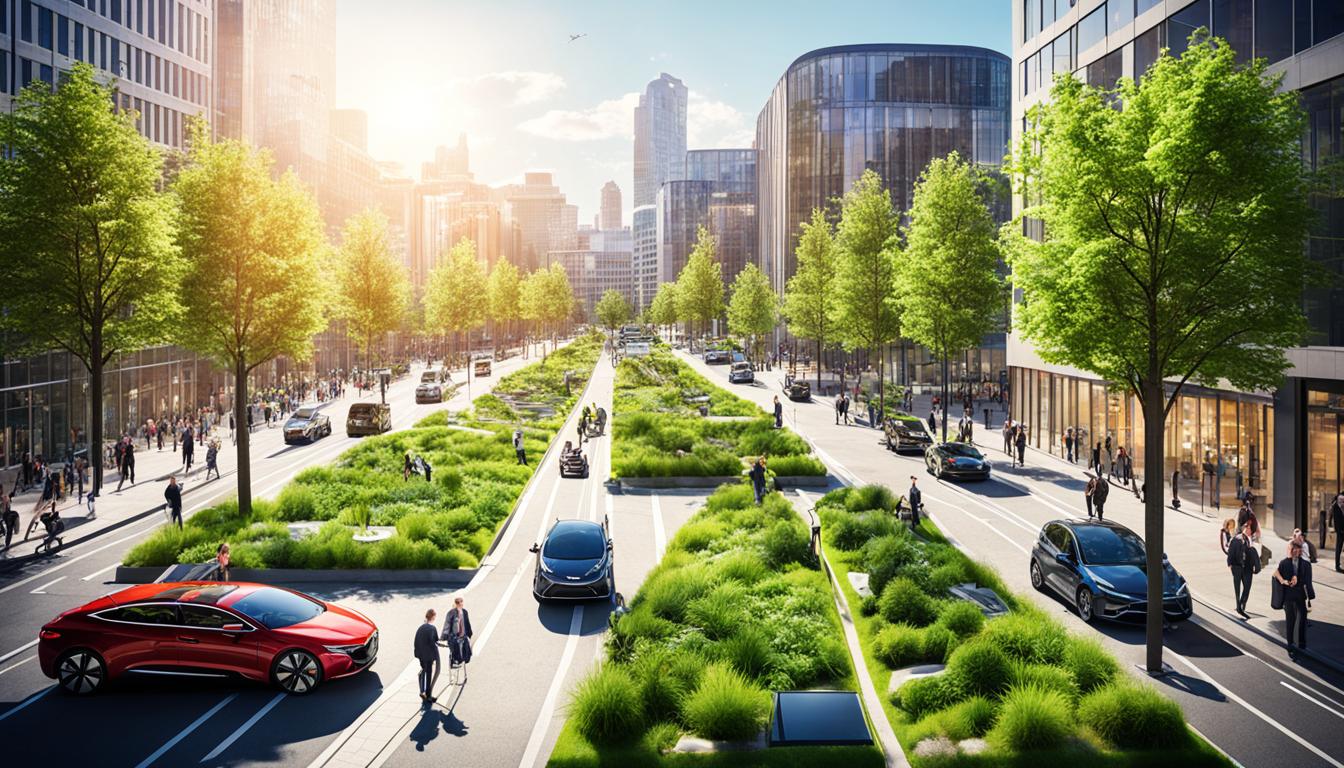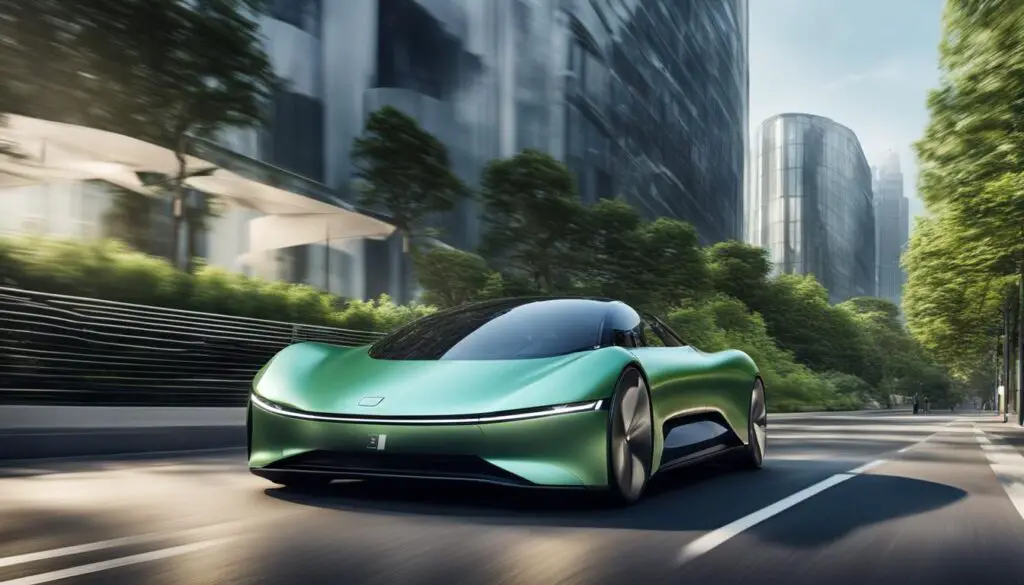
Green Wheels: The Top Sustainable Transportation Trends
The latest sustainable transportation trends are revolutionizing how we travel while protecting the environment. As we strive to reduce our carbon footprint and create a greener future, innovative solutions in transportation are gaining momentum. These trends, collectively known as “green wheels,” represent the cutting edge of sustainable transportation.
One notable trend is the rise of driverless cars. With advancements in technology, autonomous vehicles have the potential to reduce accidents and improve road safety. However, recent incidents, such as the one in Perth where a driverless car caused critical injuries, highlight the need for further development and regulation in this area.
Another significant advancement in sustainable transportation is the integration of artificial intelligence (AI) in transportation systems. AI can optimize traffic flow, reduce congestion, and improve overall efficiency. Moreover, urban design principles are embracing sustainability by implementing smart city planning, creating more pedestrian-friendly environments, and promoting the use of public transportation.
Key Takeaways:
- Driverless cars are a prominent trend in sustainable transportation, but further development and regulation are needed.
- Artificial intelligence (AI) is driving advancements in transportation systems, optimizing traffic flow, reducing congestion, and improving efficiency.
- Urban design principles, such as smart city planning, promote sustainability and encourage the use of public transportation.
Advancements in Technology for Sustainable Transportation
Technology is driving significant advancements in the field of sustainable transportation, transforming how we travel and reducing our impact on the environment. One of the key areas of progress is the integration of artificial intelligence (AI) into transportation systems.
AI has the potential to revolutionize transportation by optimizing traffic flow, reducing congestion, and improving overall efficiency. Intelligent traffic management systems can analyze real-time data and make dynamic adjustments to routes, timings, and modes of transportation to enhance the overall commuting experience.
Additionally, AI-powered autonomous vehicles are becoming more prevalent, offering an innovative solution to reduce emissions and enhance road safety. Self-driving cars utilize advanced sensors, machine learning algorithms, and high-precision mapping to navigate roads and make informed decisions, ultimately reducing the risk of accidents caused by human error.
Urban design is another area where technology is making positive strides towards sustainable transportation. Cities worldwide are adopting smart city planning principles to create pedestrian-friendly environments and encourage the use of public transportation. This includes implementing intelligent transportation systems, electric charging infrastructure, and seamless integration between different modes of transportation.
By leveraging advancements in technology, sustainable transportation becomes more accessible, efficient, and environmentally friendly. It opens up opportunities for innovative solutions and fuels the progress towards greener modes of travel.

Benefits of Technology in Sustainable Transportation
The integration of technology in sustainable transportation offers several benefits:
- Reduced emissions: AI-powered optimization algorithms can facilitate efficient routing and reduce idle time, resulting in lower greenhouse gas emissions.
- Improved safety: Self-driving vehicles equipped with AI sensors and algorithms can minimize accidents caused by human error, creating safer roads.
- Enhanced efficiency: Intelligent traffic management systems can optimize the flow of vehicles, reducing congestion and travel time.
- Promotion of public transportation: Smart city planning and digital platforms enable seamless integration between different modes of public transportation, making it more convenient and user-friendly.
- Encouragement of active transportation: Urban design influenced by technology promotes walking, cycling, and other forms of active transportation, leading to healthier and greener lifestyles.
Case Study: Singapore’s Smart Mobility Plan
“Singapore’s Smart Mobility Plan serves as a model for cities seeking sustainable transportation solutions. The city-state has implemented a comprehensive network of sensors, cameras, and communication systems to monitor traffic conditions in real-time and optimize road usage. Through data-driven insights, Singapore has successfully reduced traffic congestion and improved the efficiency of its transportation system.” – Minister of Transport, Khaw Boon Wan
Comparison of AI-Powered Transportation Systems in Major Cities
| City | Technology | Application | Benefits |
|---|---|---|---|
| New York City | AI-based traffic management system | Optimizing traffic signal timings and routing | Reduced congestion, improved travel times |
| London | AI-enabled ride-sharing platform | Efficient allocation of ride services | Reduced number of vehicles on the road, lower emissions |
| Tokyo | AI-powered autonomous buses | Providing last-mile connectivity | Enhanced accessibility, reduced reliance on private vehicles |
| Barcelona | Smart parking system | Real-time parking space availability | Reduced traffic congestion, optimized parking utilization |
The table above showcases how major cities are leveraging AI-powered technology in their transportation systems to achieve sustainability goals and improve the quality of life for residents.
The Future of Sustainable Transportation
The future of sustainable transportation is bright, thanks to ongoing efforts to develop innovative solutions. One exciting event that highlights the potential of this industry is the Global Education and Training Exhibition (GETEX) in Dubai. With a focus on future-oriented career paths in sustainability, GETEX showcases advancements in AI and leadership that are shaping the future of transportation.
GETEX serves as a platform for educational institutions to connect with students who are interested in exploring sustainable study options. From engineering to urban planning, there are numerous opportunities for future professionals to contribute to the development of sustainable transportation. With the rise of electric vehicles, infrastructure design, and smart city initiatives, the demand for skilled individuals in this field is only expected to grow.
As we continue to navigate the challenges of climate change and environmental preservation, the future of sustainable transportation will rely heavily on technological advancements and collaboration. By leveraging AI, machine learning, and data analytics, transportation systems can be optimized to reduce emissions, improve efficiency, and enhance the overall user experience. It is through strategic partnerships and interdisciplinary approaches that we can drive meaningful progress in creating a greener and more sustainable future.
The journey towards sustainable transportation is an evolving one, and it requires a collective effort from policymakers, industry leaders, researchers, and individuals like you and me. By staying informed, supporting green initiatives, and embracing sustainable alternatives, we can shape the future of transportation and make a positive impact on the world we live in.
FAQ
What are the top sustainable transportation trends?
The top sustainable transportation trends include the rise of driverless cars and the incorporation of artificial intelligence (AI) in transportation systems.
How can driverless cars contribute to sustainable transportation?
Driverless cars have the potential to reduce accidents and improve road safety, making them a promising solution for sustainable transportation.
What role does technology play in advancing sustainable transportation?
Technology, such as AI, can optimize traffic flow, reduce congestion, and improve overall efficiency in transportation systems, contributing to sustainable transportation.
How does urban design promote sustainable transportation?
Urban design incorporates sustainable principles, such as smart city planning, to create pedestrian-friendly environments and encourage the use of public transportation.
What does the future of sustainable transportation look like?
The future of sustainable transportation looks promising with ongoing efforts to develop innovative solutions, such as advancements in AI and leadership in the field of sustainability.
How can I learn more about sustainable study options in transportation?
The Global Education and Training Exhibition (GETEX) in Dubai provides a platform for educational institutions to showcase future-oriented career paths in sustainability, including advancements in AI and leadership.
Source Links
- https://www.dailymail.co.uk/news/article-13145509/Woman-fighting-life-baby-Edgewater-Perth.html
- https://economymiddleeast.com/news/getex-2024-in-dubai-to-highlight-ai-sustainability-leadership/
- https://www.insidermonkey.com/blog/the-lion-electric-company-nyselev-q4-2023-earnings-call-transcript-1268168/
